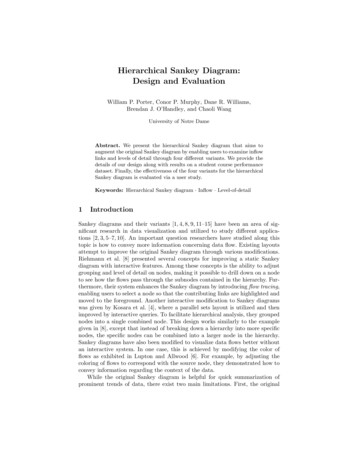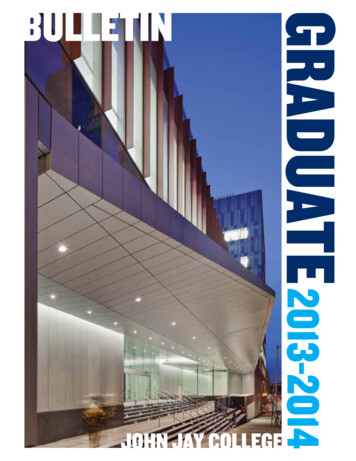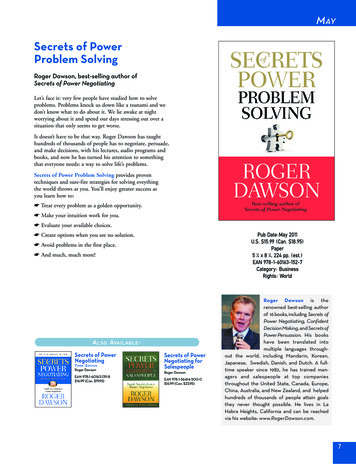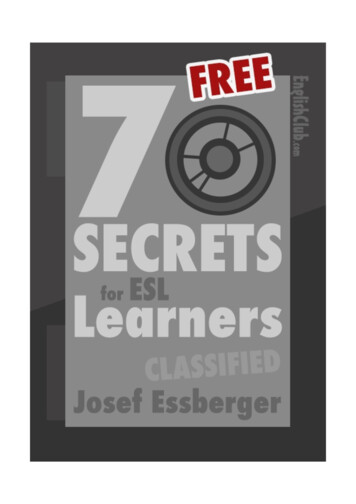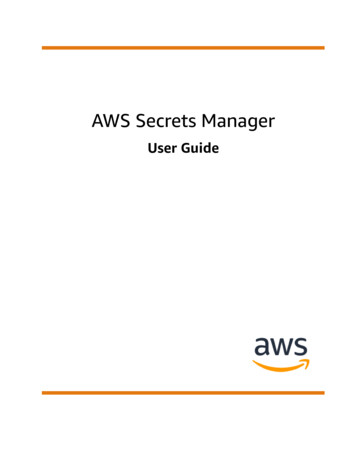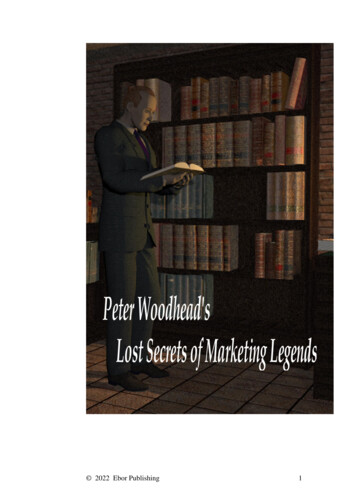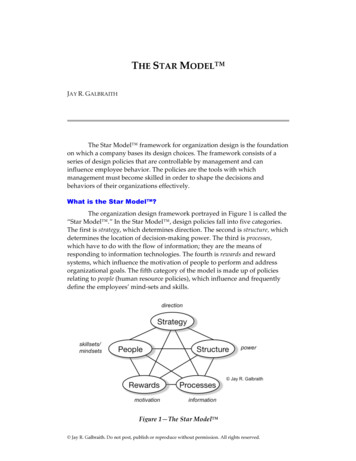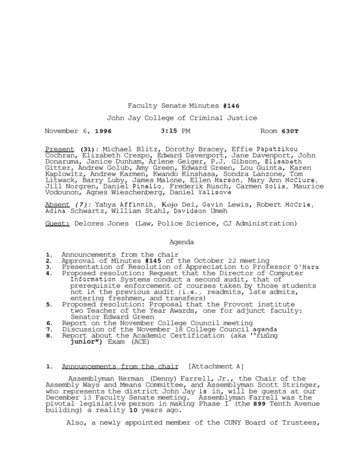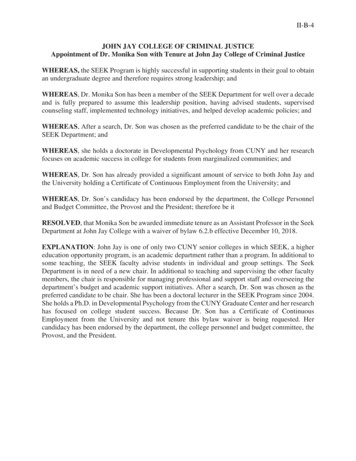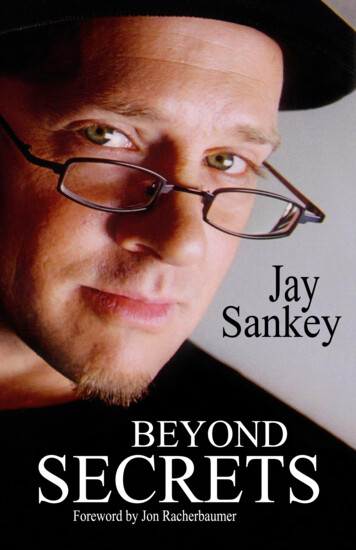
Transcription
BEYOND SECRETSBy Jay Sankey
“Strip away illusion. Retain the mystery.”- Philip Toshio Sudo
To LisaMy dearest friend and darling wife
ACKNOWLEDGEMENTSHeartfelt thanks to my friends and fellow magicians JasonMaloney, Jeff Pinsky and Richard Sanders, as well as to myparents Lloyd and Deborah, my brothers Christopher andYashin, and my sister Gretchen.Special thanks to friends and magi David Acer and David Peckfor their generous editorial help, to Jon Racherbaumer foralways being in my corner with a bouquet of roses, and to LenCooper for showing me my first magic trick.
TABLE OF CONTENTSForeword .9Preface . 12A Dance of Glances . 14Is Magic An Art? . 16Begin By Connecting. 18The Myth Of Speed . 20Incomprehensibility . 22Magic As Blood Sport . 23Orchestrating Focus. 25What Is Your Market? . 27Popular Misperceptions. 29The Anatomy Of An Effect . 31Intimate Scripts . 32What Is The Method? . 35If I Were A Real Magician . 37A Little Experiment . 39Key Images . 42Learning A Sleight. 44An Actor Playing The Part. 46Wonder Without Secrecy . 47Creating Magic . 49Wonder And Emotion . 52How Did You Do That? . 53Any Effect Is Possible . 55Cynicism, Confusion And Ego. 56For My Next Trick . 59Audience Feedback . 63The Opposite Of Magic. 65Simplicity . 67The Emotional Camera . 69The Imperfect Theory . 71The Approach . 73Inspiring Humility . 76The Wonder Of Wit . 78Classic Audience Members . 81Performing New Material . 89
Rhythm. 92Vulgar Magic. 94Whose Magic Is It? . 96Learning From Mime. 98Truth And Credibility . 99Minimum Effort . 101Performer As Product . 104What Is The Magic About? . 108Enthusiasm . 110Fewer Words, More Magic. 111Secrecy Is Fear. 113The Art Of Practice . 116Inside Out/Outside In . 117Suspending Disbelief . 119Responding . 121Parade Of Characters . 123Mirroring. 126Taking It Personally . 128Multiple Climaxes . 131Vivid Language . 133The Natural . 140Expressing And Communicating . 142Suspicion . 144Mind Over Matter. 145What Is A Narrative? . 147Magic And Mentalism. 149Vulnerability. 152Choosing A Spectator . 155Under And Over Proving . 157How Do You Feel? . 159Fear And The Sudden Audience . 161Power. 164The Mysterious And The Humorous. 166Becoming A Better Magician . 169Control And Trust . 170Circuit Practicing. 172Purge Your Puzzles . 174
Magician, Clown, Priest . 177Which Direction?. 179Magic And The Magical . 181Sanding . 184Those Who Will Resist . 186Let The Audience Lead . 189In The Blink Of An Eye . 192The Master Imagined . 194Secrets, Understanding & Wonder . 196Is There Such A Thing As A Bad Trick?. 197Articulate Hands. 199The Best Teacher. 203Random Acts Of Magic . 207Self-Expression . 209Stick To Your Weaknesses . 211Creative Promotion . 213Reminder And Promise . 216Choosing Material . 218The Play's The Thing . 220In Search Of Real Magic . 221Encouraging Co-Creation . 223Knowing And Forgetting . 225Exposure, Appreciation And Education . 227Clothing. 229Magician Vs. Entertainer . 230Tension, Expectation And Release . 232An Invitation To Wonder . 235Larger Truths . 236All Of You . 237Unpresentations . 239Ending . 241Re: Creation . 243It Takes Time . 247A New Magic . 248Effects Only Happen In The Past . 251The Love Of Magic . 255
FOREWORDJon Racherbaumer"Hey," I said. "When you, do you sort of make it up, or is it just,you know, like what happens." - Martin Amis, Money (1984)In a jokey sense, Canada is not known for spawning anythingparticularly remarkable. But, to me, the opposite is true. Someof my favorite writers--"favorite" because of how much theystimulate me--are Canadian. Canada has also spawned some ofmagicdom's most interesting and mind-tweaking magiciansand creators.The author of the book you are about to browse, buy, borrow,read, or sample is my favorite Canadian rebel angel.Jay Sankey, the existential jock of jocularity who put the "imp"in "impossible" only seems like a runaway whack-job. Do Iexaggerate? Yes and no If you pay attention and survive, his"fine madness" comes through.Besides, trying to explain or summarize what Sankey has been,what he may be, and what is likely to become is like trying toexplain a rainbow to a cat.We know that he performs, creates, writes, draws cartoons,and calls himself an "odd little man." However, he resistscategorization.If cornered-which is hard because he avoids corners-he'll tellyou that he wants more than anything to energize your "heartand mind." When he writes, he wants you to think for yourself;to free up positive feelings.9
Not long ago I wrote this about Sankey: "The fit-to be-tied Kingof Original Fits gets antsy around people who color inside lines,put things in boxes, and collect tidy categories.He gets also antsy around complacency, clichés, andpredictability. His approach instead is to immerse himself(almost to the point of drowning) in the swirling flow of hisown stream-of-consciousness, and then make everything hedoes a form of irrepressible, uncensored performance art. LikeWally Whitman, he seeks cosmic yawps.Writing books is another matter. Putting words on paper, alas,is inescapably about form. There are lots of words, sentences,and paragraphs. There are-oh, No!-categories, representations,definitions, and rules. There are restrictions, and the deeperyou delve, the deeper it gets.The good news is that Sankey's books (in theory) about theoryand practice remind me of another Canadian: MarshallMcLuhan. Pascal had his Pensées. McLuhan had his probes.Sankey, like McLuhan, puts out probes. He wants to penetrate,prick and probe your consciousness.Then he dances off the last page. At that abrupt point, you mustcarry on where he left off. Granted: He will have had much tobabble about regarding his adventures on both sides of theLooking Glass. But he would also caution you that his words (inall their zippity-doo-da splendor) are only a kind of mapping,not be confused with the actual territory.If you have seen Jay perform or lecture, you know he casts thatspell. This work is both skeletal and fleshy. As you experienceit (Note that I did not say "read'), remember the physicality ofhis live performances. This book is a different kind ofperformance.10
Yet you will discover lots of fitful and fanciful acting andreacting, lots of pacing and protestation, lots of stopping,starting, turning, jumping, and jabbing. In the process, he willdisarm you by openly and tacitly showing that writing, like alive performance, boils down to two things: you and him.And as he often confesses, you, the reader, the spectator, haveall the power. Not him. All he has are the tricks of his trade, theplayfulness of his patter, the evocativeness of his prose, and hisability to orchestrate what is likely to happen as it happens.If he can stay two or three beats ahead of the "flow" and aheadof your capacity to perceive what he perceives before you do,then you will giggle, guffaw, or experience illumination. In thiswork, Sankey literally brings you up to speed-your speed andhis speed.Jay understands that spectators and readers only invest timeand emotions in things, people, and books they care about.Therefore, when he performs a trick, does something comedic,draws a cartoon, or writes a book, he is mindful of you.This is the "magic" of this book because it will ultimately beabout you. Jay wants you to care about the things, ideas, andtheories he has written about. So as you experience this book,drop your defenses, pretenses, and presumptions.Let Jay relentlessly and teasingly "probe" you to get involved,to be helplessly and happily part of his "world"-a paralleluniverse he wants you to love as much as he loved making it.Be ready. Be open. Let it happen. Soon the balls, every damnone of them, will be in your court and you will have a helluvatime playing with them.July 13, 2003 New Orleans, Louisiana11
PREFACE"You see things; and say, ‘Why?’ But I dream things that neverwere; and I say, ‘Why not?” – George Bernard ShawI am primarily a close-up magician. Though I have performedhundreds of children's shows, spent more than a few days as astreet magician, dabbled in mentalism and performed as aprofessional stand-up comic on the stages of countless comedyclubs, my forte and venue of choice is performing sleight-ofhand magic for intimate audiences.Over the last twenty-eight years I have performed my close-upmagic at restaurants, bars, house parties, trade shows, productlaunches, business meetings, cocktail parties and resorts allover the world.I have also performed and lectured at magician's conventionsand clubs in over a dozen different countries. I tell you all this,not in the hope of impressing you, but rather to give you someidea of the experiences out of which my views, preferences andprejudices have been born.I am keenly aware of the subjectivity and profound limitationsof my own perspective (though that awareness in no wayprevents me from nonetheless reveling and even rejoicing inthat perspective).On the other hand, I have passionately attempted to not limitmy words strictly to my own experience, but rather to writewith one eye on my own work and the other eye on a widerange of imaginings of what I think and feel magic could be andperhaps even should be (as a result, some readers willundoubtedly criticize this book as being cross-eyed).12
Some passages are especially critical of certain attitudes,trends and approaches towards magic. I am keenly aware thatmy own work is not exempt from the shortcomings of thesevery same attitudes.In fact, I believe it is precisely because of their subtle presencein my own work that I criticize them with such passion.This is an unabashedly ambitious book and explores suchseminal questions as, "How can you express your creativitythrough magic?" "How can you emotionally engage youraudience?" "How can your work be honest?" and "How can yourefine your skills?"The answers I offer are mine. Perhaps they will in some wayassist you in finding yours.Jay Sankey Toronto, Canada September, 200313
A DANCE OF GLANCES"I see you see me." Jean-Paul SartreI love the intimacy of close-up magic and especially thechallenging work of maintaining a variety of relationships withseveral people at the same time. This maintenance is achievedin many ways, though ultimately much of it comes down tosight, sound and touch. Glances, words and physical contact.Of course, very few routines are constructed in such a way thatyou touch every member of the audience (without going tojail). Though you can direct your comments towards a singlemember of the crowd, your words are usually heard byeveryone present. Which is why, to first initiate and thendevelop different relationships with the individualpersonalities making up your audience, glances can often bethe most effective means.You glance at a spectator; then shift your glance to a secondspectator, and as your glance shifts, the first spectator glancesat a third spectator.And so it goes, everyone ceaselessly "checking in" with eachother even as you all take part in the group activity of creatingthe magic effect.A glance takes but a moment to deliver and receive, and in thatmoment an incredible amount of information and feeling canbe conveyed. At the same time, glances can be completelyprivate, even while surrounded by other people.And unlike words said above a whisper, every glance can besublimely tailored to the moment and recipient.14
As the above Sartre quote suggests, even a fleeting glancedirectly into the eyes of another human being is a multilayered event analogous to two mirrors suddenly turned toface each other, creating an opportunity for an almost infiniteinterplay.Looking into the eyes of a member of the audience, I see themjust as surely as they see me. And they see that I see them. AndI see that they see me. And so on.During a performance of close-up magic, I am forever shiftingmy gaze from participant to participant, and as the showunfolds, these glances acquire a history, even a familiarity. As aresult, we begin to see each other in a richer, more individuallight.When I look into someone's eyes, it is as if I have just droppeda penny into a well with no idea of how far it may fall.Sometimes I discover the well is frozen and the penny'sdescent is stopped dead. More often, the waters are morereceptive. And quite regularly, the coin falls deeper than I cangauge.My job as a performing artist is to follow the coin and make themost of wherever it lands. Words and touch are undoubtedlytranscendent tools, but when it comes to nurturing unique,individual relationships in a close-up magic setting, the eyesdefinitely have it.15
IS MAGIC AN ART?“I think you get the most interesting work done in fields wherepeople don’t feel they’re doing art, but are merely practicing acraft.” Douglas AdamsThis perennial question is a lot like asking, "Is painting an art?"My answer is, "It can be." Like a pack of playing cards or a fewrubber bands, neither paint nor canvas is inherently "artistic."Just as with painting, with magic too the question of whetheror not it is artistic comes down to the work of the individualpractitioner. Instead of the tired question, "Is magic an art?" Ibelieve the question "Can magic be artistic?" speaks more tothe point.Naturally, before we can explore the possible relationshipsbetween two ideas we would do well to first define both. In thisinstance, by the word "magic" I mean a performance of magicand by "artistic" I mean (and here is precisely when, all toooften, a tiny black car pulls up, the passenger door opens and astream of smirking clowns pours out) an individual is able toexpress something about his or her unique point of view on theworld through the medium.When the practitioner is able to do this, I consider him or heran "artist" and their work as "artistic." In this way, I use theword "artistic" as a completely non-evaluative term.For me, whether or not I enjoy or am able to appreciate certainwork in no way determines my use of the word, "art." If thework is self-expressive, it is art.16
Consequently, my answer to the question of, "Is magic an art?"is quite simple. When the magician expresses him or herselfthrough their performance, it is art.On the other hand, when the magician performs effects andhandlings created by others, accompanied by scripts largelycopied from other sources with a character lacking any realcreativity, the fellow is not an "artist" nor his work "artistic," asentertaining as it may well be.17
BEGIN BY CONNECTING“Always be inviting the audience into your theatre.” – SanfordMeisnerInstead of waiting for your audience to extend their attentionand energy to you, extend yourself to them. "Go to them," butnot in a pushy or controlling way. Ideally, offer yourself tothem in the hope of connecting to them, as they are, in thatmoment.First establish this connection before attempting to guide youraudience in a direction. Too many performers, in theirenthusiasm (and their underlying insecurity) start their showswith a rush of energy and run the risk of leaving theiraudiences behind, sitting there in their seats watching the jettake off without them.Of course, energy, especially at the start of a performance isalways a good idea, but put that energy into connecting. It onlytakes a few moments to establish a solid connection. Oncedone, you will find your audience far more receptive to gettingon your jet.Your eyes are of course one of the most effective ways toestablish this all-important connection. When performingclose-up, take a moment to look everyone in the eyes and senda friendly message of, "Hello. It is very nice to meet you. I amglad you are here."Performing onstage in front of eight hundred people is anothermatter. In such a case, be sure to take the entire audience intoyour introductory gaze by slowly turning your head from oneside of the audience to the other.18
I also think it is worth taking a moment or two to silently greetthe handful of people you can actually see in the first few rows.Make the most of the fact that you can see them and that theycan see that you can see them.A little smile or a friendly nod is all it takes. It is equallyimportant to send your energy to the very back of the theatrebecause they are the ones most likely to feel distanced from theexperience.19
THE MYTH OF SPEED"The hand is quicker than the eye." - Traditional ExpressionFew phrases have done more harm to the art of magic than theone cited above. Ironically, even as it refers to sight, theimplications of the expression have powerfully blinded bothmagicians and the lay public.In the minds of the general public, it perpetuates the grosslybelittling generalization that when all is said and done, the artof magic comes down to fast hands, while in the minds ofsleight-of-hand students it suggests that speed is a magician'sally.The reality is that speed is more often an enemy of the illusionthan a friend. Few things will ever draw attention to a sleightand spark suspicion more consistently than a fast execution.Actually, speed does harm to almost every aspect of our craft,from quickly performed sleights and hurriedly delivered linesof script to a rushed first climax or even a sudden, forcedchange of facial expression.Speed usually requires a burst of energy that in most contextsonly serves to break the spell, inspire suspicion and snap thegentle thread connecting the performer and audience. Speedalso often leads to confusion or creates the impression that theperformer is anxious.However, as usual there are exceptions. For example, when Iexecute the Classic Pass or Marlo's "In Lieu of the Through theFist Move," (sometimes referred to as "The Twirl Change") Iemploy a burst of speed.20
But in each case, these small, fast movements are concealedwithin a larger action like a cloth thrown over a birdcage toquiet the occupant's song.I can still remember the night, after I had been performingstand-up comedy for only a year or two, when a much moreseasoned comic took me aside and gently suggested that I trydoing my act, not just a little slower, but at half the speed.I was extremely skeptical and immediately imagined strained,excruciating silences, but I agreed to try it. Not surprisingly, itwas very difficult for me to do and it felt more than a littleunnatural, even disorienting. But after a half-dozen moreshows, I had to admit, performing at a slower pace yieldedstronger audience reaction.Slow down your thoughts, hands and words. Relax. Take adeep breath and hold it for several beats. Then slowly let it out.Perform your magic slowly and steadily.How else do you expect your audience to have the opportunityto fully experience and appreciate it? And given that theaudience's visual experience of an effect makes up a large partof their understanding, handle your props and execute yourmoves so that your hands, rather than being quicker than theireyes are much slower than their eyes.All too often, when the hand is quicker than the eye, thewonder is lost.21
INCOMPREHENSIBILITY“No object is mysterious. The mystery is your eye.” - ElizabethBowenA lack of understanding does not necessarily create a sense ofmystery. A confusing magic effect is a perfect example of this(though "a confused magic effect" may be a more accuratephrase because there are far fewer inherently confusing effectsthan there are confusing ways of presenting effects).If you share an effect with your audience and unintentionallylose them somewhere along the way, perhaps because youraced through an important part or neglected to clarify aninitial condition, at the end of the routine the audience will failto grasp the overall effect.This lack of understanding will create confusion and possiblyfrustration, but not a sense of mystery. Paradoxically, mysteryrequires clarity, even a certainty as to the events surroundingthe mystery.22
MAGIC AS BLOOD SPORT“The camera makes everyone a tourist in other people’s reality,and eventually in one’s own.” – Susan SontagThere is something fascist about the present zeal for "freakingpeople out." While magicians once strived to charm, delight,seduce and entertain, there is now a generation of magicianswho seem intent solely on "frying" or "destroying" people. It isas if for these performers, there is no kind of movie other thanaction flicks. Gone are the dramas, romances and comedies.Not surprisingly, this narrow-minded lust for screams, shoutsand other overt signs of mental meltdown is a direct result ofthe television culture and in particular the manner in whichmany of the "street magic" shows are now produced.Turning the camera from the magician to the astonishedspectator, from the doer to the done-to, is an inspiredtechnique and brings a whole new drama and vitality totelevised magic.But as is typical with that medium, these shows feature onlythe most obvious reactions. People who are "merely" amused,charmed, befuddled, delighted, d
The author of the book you are about to browse, buy, borrow, read, or sample is my favorite Canadian rebel angel. Jay Sankey, the existential jock of jocularity who put the "imp" in "impossible" only seems like a runaway whack-job. Do I exaggerate? Yes and no If you pay attention and survive, his "fine madness" comes through.
